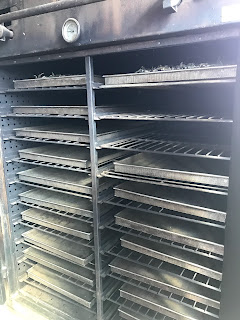Today we visited the herbal farm that produces raw materials for the hospital to produce herbal drugs. There are two process, growing the plants and then drying the plants. Once the plants are done growing, they are washed 3 times and then chopped up into small pieces.
This is a picture of them cutting up the plants into smaller pieces so they can dry.
The pharmacist that took us on a tour is in charge of making sure the herbals are safe for consumers to take. If they are not they will be banned from being used. If the plants are not dried 100% they can get contaminated with fungus. Therefore they have a machine that they put he herbs into to make sure they are completely dried.
This is the machine that dries them completely.
The duration that the plant takes to grow depends on the chemical content in the plant. The farmer knows the exact time that it takes for each plant. Once the plants are dried and packaged up they fill out a form that has information about the plant when it was made and where it was made. If anything goes wrong with this batch they are able to trace it back to the farm and figure out the problem. They have a warehouse where they store all the finished products before it is shipped to the hospital. The total amount of money the
farmer got for the past year was about 5 million baht. They try to give he farmer 10% more then the commercial price to ensure good quality and farming.
This is a picture of the plants on the drying rack. This particular plant is used for allergies and inflammation.
This is a plant that is used to reduce cholesterol.
This plant is used to reduce fever and get rid of herpes
infection.
These berries are used for gastritis. A few students tried these berries and said they were very bitter.
This plant is what camphor is made out of it. You could tell what is was from the smell.
This plant is known as the king of hangovers. People can put the leafs in tea and drink it is also show.
The second half of the day we visited the Chao Phya Abhaibhuejhr Hospital. There are 42 herbal hospitals in Thailand, and this hospital was the very first herbal hospital to open. The hospital had 3 departments the outpatient,
inpatient and spa. The outpatient department offered services such as Thai massage, oil massage, foot massage and facials. It also offered herbal compress and acupuncture. This department also had a Thai traditional medicine clinic and psoriasis clinic. The inpatient
department had both traditional and alternative medicine. Additionally they had a stroke unit and a post-part in unit
that involved massages to stimulate lactation. The spa is
used to restore balance of the 4 elements, earth, wind, fire and water. The hospital also has various programs for kids to learn about traditional Thai medicine. The one I found most interesting was the Project Grateful Kids. This project taught kids how to give Thai foot massages so that the kids could go home and give them to their parents.
After this we visited the museum at the hospital. The museum is there to educate people about herbals and promote their use. It has now been open for 20 years and is open to both Thai people and tourist. At the museum a patient will first get their vitals taken. Then they will decide which herbal the patient needs. They will weight it out on a balance and then put it in a bag. Each bag lasts the patient approximately 7 days. They take a little bit of the herbs and steep it in the water and then drink it.
Behind the counter is many drawers that have all he herbs the patients might need.
This is a group picture in front of the museum.
This is a group picture of us students and the staff that led us around the hospital.















No comments:
Post a Comment